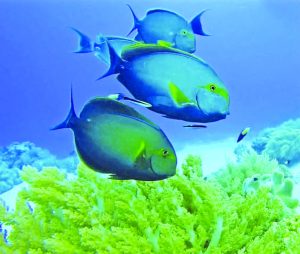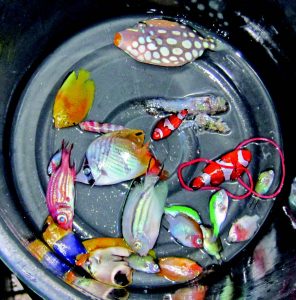Like many Animal Scene readers, I grew up with fish. From a classic 20-gallon freshwater tank with ceramic treasure chests and neon tetras, our family’s collection grew to 10 tanks—at one point holding everything from seahorses to local shrimp and guppies ‘rescued’ from a canal near our house!
Having worked in various environmental organizations, I’ve tried to apply the concepts I’ve learned to enhance the trade in fish and other natural resources I’d like to share a little tale and a few suggestions to help enhance our local marine aquarium trade.
Cartimar in the Late 2000s
Mesmerized by the explosion of colors inside a marine fish store, a boy points to a bright yellow fish with a Pinocchio-like nose, its face neatly hidden by a black mask. Known to science as Forcipiger flavissimus, the longnose butterfly fish is easy on the eyes but hard to keep alive. The boy’s been parked in front of the aquarium for at least 20 minutes. Must’ve been a hard choice.
Wordlessly, the guardian of this humid, bubbling world scoops up the fish with a worn green net and chucks it into a plastic bag. “That’ll be fifty pesos.”Welcome to Marine Fish Central, the Cartimar pet complex in Metro Manila’s Pasay City, where thousands of fish – and pesos – change hands daily. I’ve been in the boy’s shoes more times than I can remember, ever since our grandma took us to see ‘real live seahorses’ in the 1980s. Composed of about a hundred shops offering arowanas, tarantulas, and everything in between, the complex has seen many changes but remains the country’s top aquarium fish hub.
Sea Creatures for Sale
There are three basic types of fish – saltwater fish from the sea, freshwater fish from rivers or lakes, and brackish water fish from zones where fresh and saltwater mix. Because of the volatile nature of rivers, most fresh and brackish water fish have learned to adapt to dramatic fluctuations in water quality.
Freshwater fish like the country’s introduced tilapia species can, for example, rapidly adapt to brown-water conditions each time monsoon rains engorge rivers with mud and silt. In contrast, brightly-hued saltwater or marine fish live in the single most stable environment on Earth – the ocean – where large-scale changes occur not in days, but in millennia. Because of this, most are unprepared for life in the average home aquarium, where water parameters fluctuate daily.
In the 1970s, new technologies such as canister filters, ultraviolet sterilizers, protein skimmers plus artificial sea salt finally allowed hobbyists to keep the sea’s living jewels. By 1992, the annual global trade in marine ornamentals soared to US$ 360 million, involving 36 million fish. Today the trade is valued at over US$ 1 billion, with 40 nations supplying some 2,000 marine fish and 650 invertebrate species to a host of countries – primarily the United States (which imports half the world’s marine ornamental fish), Japan, and Western Europe.
Today, the Philippines and Indonesia remain the world’s top exporters of wild-caught marine fish, supplying about 85% of global demand. In 1998, the Philippines netted an estimated US$ 6.4 million in marine fish exports – buoying the lives and livelihoods of around 4,000 aquarium fish collectors based throughout the archipelago.
Unfortunately, in the Philippines, as many as nine out of ten wild-caught marine ornamental fish die within one year of capture. Due to current capture, transport and shipping practices, about 80% of all marine fish die even before they are sold to hobbyists. As much as 90% of all ornamental marine fish that are sold die within the first year. Only the hardiest – clownfish, damselfish, wrasses, gobies and blennies – or those lucky enough to be bought by elite hobbyists, survive beyond their first year in captivity.
Tips for a Sustainable Trade
The Best Alternatives Campaign is currently working on practical solutions for a sustainable marine aquarium trade.
A recurring issue is the use of sodium cyanide, thought to have originated in the Philippines in the 1950s. An efficient nerve-toxin, cyanide is squirted into coral heads or rock crevices to stun hard-to-catch fish. Unfortunately, the mixture burns both corals and the vital organs of fish – resulting in the deaths of up to 75% of all living things exposed to it.
Regulated collection using nets and not poisons, better stocking and shipping techniques plus imposing sensible size, catch and species limits can provide collectors both sustainable livelihoods and a strong incentive to protect instead of exploit reefs. Among its initial recommendations are the following:
- Avoid hard-to-keep fish, especially cleaner wrasses, mandarin dragonets, Moorish idols, and all types of seahorses. Mortality rates for these fish are estimated at 99% so it is best to ban them entirely.
- Promote hardy fish. Many of the world’s most successful aquaria feature hardy but still colourful clownfish, damsels, gobies, wrasses, and surgeonfish. Survival rates are far better and hobbyists end up spending much less for upkeep and stock replacement.
- Shift to artificial corals and invertebrates. Unless you are a reef aquarium expert with cutting-edge equipment and a bottomless bank account, steer clear of all stationary invertebrates like corals, sponges, and sea anemones. Their care is dramatically more complex than already difficult-to-keep reef fish and mortality rates are alarming. Moreover, harvesting wild hard corals for both the pet and curio trades is illegal. If tank-raised corals are unavailable, then artificial corals and reef blocks are excellent alternatives. The best part? You’ll only ever buy them once.
- Shift to aquacultured fish and invertebrates. In stark contrast to freshwater aquarium fish, 95% of all marine fish and invertebrates remain wild-caught. Fortunately, the Bureau of Fisheries and Aquatic Resources (BFAR) recently approved a program where fish farmers can apply for wildlife ranching permits, allowing aquaculturists to collect a preset number of wild individuals as brood-stock in exchange for the release of 30% of juveniles back into the wild. Farmed seahorses and clownfish are popular in other countries – they might soon be available for Filipino hobbyists.
- Raise the prices of saltwater fish and invertebrates. The reality of marine fishkeeping is that it is not for everyone. Higher prices limit the hobby to those with the time, resources and discipline to keep the animals alive. More importantly, this translates to better incomes for local fishermen, who will earn more from catching less fish.
- Hobbyists, pet stores and traders must self-regulate to ensure that new inductees are accorded the proper knowledge, training and respect for life needed to keep marine fish mortalities at an absolute minimum.
I’ve since swapped my marine aquaria for freshwater tanks populated exclusively by farmed fish like Amazonian tetras and catfish. I’m also in touch with dedicated and highly-capable reef keepers and marine aquarium specialists. Certainly the marine aquarium trade has its merits. Corals, giant clams and a growing list of fishes can now be cultured not just for profit – but to someday repopulate Earth’s denuded reefs once the full fury of bleaching hits our oceans. More importantly, the hobby cultivates a love and understanding of nature and its myriad processes.
Back at the fish store, a fresh batch of kids enters. Stopping to inspect the rows of aquaria, they fall silent.
As they watch and wonder at the swirling melee of colour, I look back at another boy, gaping wide-eyed at a tank-full of ‘real live seahorses’ almost 30 years ago. It all happened in Cartimar – where marines live, but never grow old.
This appeared in Animal Scene magazine’s July 2018 issue.









